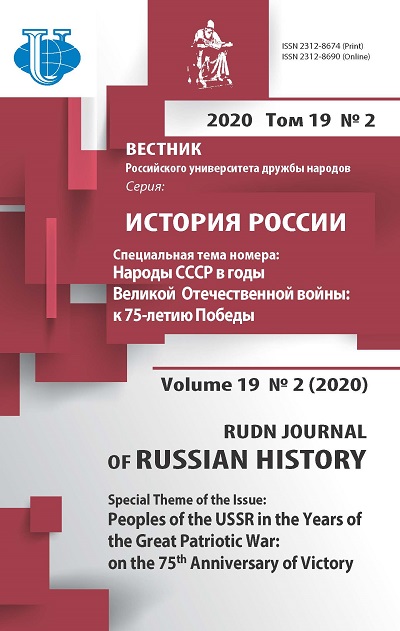The Military Routine of Polish Partisan Detachments Operating on the Territory of the Byelorussian SSR in 1943-1944: Morale and Political Propaganda
- Authors: Blagov S.V.1
-
Affiliations:
- Kaliningrad State Technical University
- Issue: Vol 19, No 2 (2020): PEOPLES OF THE USSR IN THE YEARS OF THE GREAT PATRIOTIC WAR: ON THE 75th ANNIVERSARY OF VICTORY
- Pages: 349-360
- Section: PEOPLES OF THE USSR IN THE YEARS OF THE GREAT PATRIOTIC WAR: ON THE 75th ANNIVERSARY OF VICTORY
- URL: https://journals.rudn.ru/russian-history/article/view/23776
- DOI: https://doi.org/10.22363/2312-8674-2020-19-2-349-360
Cite item
Full text / tables, figures
Abstract
There were five Polish national detachments within the Soviet partisan movement that officially operated on the territory of the Belorussian SSR during the Great Patriotic War. Their formation took place in 1943-1944. Each of them had their own special features, their own specific tasks; but they also had common characteristics. First of all, the partisans were associated with proSoviet political propaganda. In their actions, they were used as guides to the local population of Western Belarus, spreading ideas that had been elaborated by the Polish Communists. The author studies the impact of Soviet agitation on Polish partisan detachments, and investigates how much the Polish partisans were subjected to these ideas in their everyday life. Back in 1939-1941, a significant part of the Polish population of the western regions of the USSR had been subjected to repressions. Therefore, in the first months of the Great Patriotic war these people often supported the German occupiers. Why then would parts of the Polish population join the Soviet partisans? The Soviet command changed their attitude towards them, creating the opportunity for Polish partisans to keep their national traditions and to wear their military uniforms, in order to win the sympathy of the local Poles. They even accepted former “anti-Soviet elements” who had been put in prison in 1939-1941 but joined the “red” underground. Some of the formations were not totally covered by the “left” ideology and did not associate themselves with the Communists when agitating among the local population.
About the authors
Sergey V. Blagov
Kaliningrad State Technical University
Author for correspondence.
Email: press@klgtu.ru
Senior Lecturer of the Department of History
1, Sovetsky Ave., Kaliningrad, 236022, RussiaReferences
- Adamushko, V.I. OUN-UPA v Belarusi. 1939–1953 gg. Dokumenty i materialy. Minsk: Vysheyshaya shkola Publ., 2012 (in Russian).
- Barabash, V.V. Polyaki v antifashistskoy bor'be na territorii Belarusi (1941–1944 gg.). Grodno: GrGU Publ., 1998 (in Russian).
- Boradyn, Z. Niemen – rzeka niezgody. Polsko-sowiecka wojna partyzancka na Nowogródczyźnie, 1943–1944. Warszawa: Oficyna wydawnicza RYTM Publ., 1999 (in Polish).
- Blagov, S.V. “Social portrait of the partisan of the Polish partisan detachment on the example of the BSHPD units in 1943–1944.” Questions of National and Federal Relations 8, no. 6 (2018): 873–905 (in Russian).
- Blagov, S.V. “About the unsuccessful attempt of the creation of the Polish partisan formations during the Great Patriotic war.” RGGU Bulletin. Political Science. History. International Relations, no. 2 (2019): 110–130 (in Russian).
- Juchniewicz, M. Polacy w radzieckim ruchu podziemnym i partyzanckim, 1941–1944. Warszawa: Wojskowy Instytut Historyczny Publ., 1975 (in Polish).
- Kuz'min, A.T. Vsenarodnaya bor'ba v Belorussii protiv nemetsko-fashistskikh zakhvatchikov v gody Velikoy Otechestvennoy voyny. Minsk: Belarus' Publ., 1985 (in Russian).
- Manayenkov, A.L. Partizanskiye formirovaniya Belorussii v gody Velikoy Otechestvennoy voyny (iyun' 1941 – iyul' 1944). Minsk: Belarus' Publ., 1983 (in Russian).
- Musiał, B. Sowieccy partyzanci 1941–1944. Mity i rzeczywistość. Poznań: Zysk i S-ka Publ., 2014 (in Polish).
- Tobiash, Yu. V yedinom stroyu. Vospominaniya uchastnikov partizanskogo dvizheniya v Belorussii. Minsk: Belarus' Publ., 1970 (in Russian).
- Williamson, D.G. Polski ruch oporu 1939–1947. Poznań: Dom wydawniczy REBIS Publ., 2015 (in Polish).
















